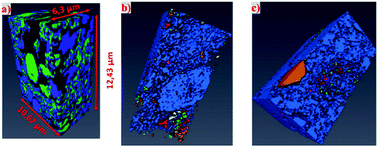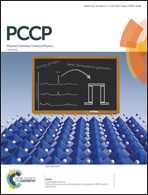Microstructure degradation of Ni/CGO anodes for solid oxide fuel cells after long operation time using 3D reconstructions by FIB tomography†
Abstract
Solid oxide fuel cells (SOFCs) are electrochemical conversion devices, which essentially consist of two porous electrodes separated by a dense, oxide ion conducting electrolyte. The performance and the durability of SOFCs strongly depend on the electrode microstructure. In this paper, the impact of a relatively long exposure time (up to 20 000 h) under realistic operation terms (temperature (T) = 850 °C, current density (J) = 190–250 mA cm−2) in the kinetics of microstructural degradation are investigated for porous nickel (Ni)/ceria gadolinium oxide (CGO) anodes, to understand the microstructural evolution in SOFC cermet anodes. A combined system of Focused Ion Beam (FIB) and Scanning Electron Microscope (SEM) tomography was used to analyze various anode microstructures aged during different operating times (2500 h, 15 000 h and 20 000 h). The methodologies of image acquisition as well as the segmentation and the object recognition were improved, offering a reliable quantification of Ni-grain growth, connectivity, tortuosity factor and triple phase boundary length (TPBL). The representative volume element (RVE) was also studied, and its dependence on aging time was confirmed. To construct a volume that can be accurate and representative for the whole sample, the necessary corresponding 3D reconstruction size was adjusted by increasing operating time, in order to suppress the influence of microstructure variation caused by Ni and CGO agglomeration. Statistically significant 3D microstructural changes were observed in the anode by increasing the operating time, including nickel particle size distribution, changes in connectivity of the ceramic part (CGO) and a significant decrease of contiguous triple phase boundary densities. Additional qualitative observations were done in order to gain a complete insight of the degradation phenomena in nickel based cermet anodes.



 Please wait while we load your content...
Please wait while we load your content...